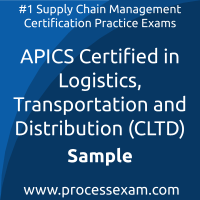 You have to pass the CLTD exam to receive the certification from ASCM. To increase the effectiveness of your study and make you familiar with the actual exam pattern, we have prepared this ASCM APICS Certified in Logistics, Transportation and Distribution sample questions. Our Sample ASCM APICS Certified in Logistics, Transportation and Distribution Practice Exam will give you more insight about both the type and the difficulty level of the questions on the ASCM APICS CLTD exam.
You have to pass the CLTD exam to receive the certification from ASCM. To increase the effectiveness of your study and make you familiar with the actual exam pattern, we have prepared this ASCM APICS Certified in Logistics, Transportation and Distribution sample questions. Our Sample ASCM APICS Certified in Logistics, Transportation and Distribution Practice Exam will give you more insight about both the type and the difficulty level of the questions on the ASCM APICS CLTD exam.
However, we are strongly recommending practice with our Premium APICS Certified in Logistics, Transportation and Distribution (CLTD) Practice Exam to achieve the best score in your actual ASCM CLTD Exam. The premium practice exam questions are more comprehensive, exam oriented, scenario-based and exact match of ASCM APICS Certified in Logistics, Transportation and Distribution exam questions.
ASCM APICS Certified in Logistics, Transportation and Distribution Sample Questions:
01. Which international trade theory is said to be the one underlying most international product trades?
a) International product life cycle
b) Theory of absolute advantage
c) Theory of comparative advantage
d) The cluster theory
02. What tool can be used to denote where push operations in a logistics network give way to pull operations?
a) House of lean
b) Balanced scorecard
c) Dashboard
d) Value stream map
03. The task that best describes the value proposition offered by freight forwarders is that they:
a) act as agents for domestic firms in international markets, primarily obtaining orders for their clients’ products
b) export goods and services and locates overseas buyers on their clients’ behalf.
c) consolidate shipments from various customers and offer lower transportation rates.
d) operate under power of attorney from the shipper to pay all import duties and are ultimately liable for unpaid duties.
04. If a firm is concerned with high duty rates, on which of the following criteria should it focus?
a) Type of goods imported and their cost
b) Type of goods imported and their value
c) Type of goods exported and their value
d) Type of goods exported and their cost
05. Which of the following prerequisites is essential in order to establish an effective order management system?
a) An ability to reserve inventory and determine a delivery date
b) An ability to understand customer needs
c) An ability to plan and build loads
d) An ability to receive, enter, and validate an orders
06. One of the primary reasons that supplier relationship management (SRM) is integral to so many companies operations is that the procurement of raw materials
a) can be equal between 40 to 70 percent of each sales dollar.
b) may be slightly more predictable when working with preferred suppliers.
c) may be challenging when trying to source raw materials or components that are in high demand for a seasonal product.
d) will require the manufacturer to rely exclusively upon a single supplier for particular component.
07. What illustrates the principle of demurrage?
a) A warehouse operator leases off-site storage facilities to handle occasional stock overflow.
b) A trailer is left unloaded in the warehouse yard. A fee is added to the transport bill.
c) Goods are stored in the warehouse but not on a "free on board" (FOB) basis.
d) Inventory is stored in secure buildings outside the warehouse but on business property.
08. Which of the following categories is a weakness of the rail systems?
a) Safety records
b) Inflexible infrastructures
c) Effects of the weather
d) Routes from city centers
09. As a means to protect domestic industries, which of the following requirements is an example of a non-trade barrier?
a) Requesting a mandatory consular invoice
b) Utilizing Convention on International Sale of Goods (CISG)
c) Mandating compliance with triple bottom line (TBL)
d) Demanding process efficiency
10. Which cost tends to fall as more distribution centers are added to a logistics network?
a) Inbound transportation costs
b) Inventory costs
c) Facility and systems costs
d) Outbound transportation costs
Answers:
Question: 01
Answer: c |
Question: 02
Answer: d |
Question: 03
Answer: c |
Question: 04
Answer: b |
Question: 05
Answer: c |
Question: 06
Answer: a |
Question: 07
Answer: b |
Question: 08
Answer: d |
Question: 09
Answer: c |
Question: 10
Answer: d |
If you find any errors or typos in APICS Certified in Logistics, Transportation and Distribution (CLTD) sample question-answers or online ASCM APICS CLTD practice exam, please report them to us on feedback@processexam.com
 You have to pass the CLTD exam to receive the certification from ASCM. To increase the effectiveness of your study and make you familiar with the actual exam pattern, we have prepared this ASCM APICS Certified in Logistics, Transportation and Distribution sample questions. Our Sample ASCM APICS Certified in Logistics, Transportation and Distribution Practice Exam will give you more insight about both the type and the difficulty level of the questions on the ASCM APICS CLTD exam.
You have to pass the CLTD exam to receive the certification from ASCM. To increase the effectiveness of your study and make you familiar with the actual exam pattern, we have prepared this ASCM APICS Certified in Logistics, Transportation and Distribution sample questions. Our Sample ASCM APICS Certified in Logistics, Transportation and Distribution Practice Exam will give you more insight about both the type and the difficulty level of the questions on the ASCM APICS CLTD exam.